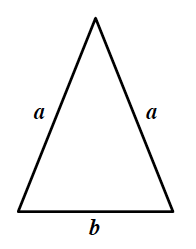Science:Math Exam Resources/Courses/MATH102/December 2011/Question 09
{{#incat:MER QGQ flag|{{#incat:MER QGH flag|{{#incat:MER QGS flag|}}}}}}
• Q1 (a) i • Q1 (a) ii • Q1 (b) i • Q1 (b) ii • Q1 (b) iii • Q1 (c) • Q2 (a) i • Q2 (a) ii • Q2 (a) iii • Q2 (b) i • Q2 (b) ii • Q2 (b) iii • Q2 (c) • Q3 • Q4 (i) • Q4 (ii) • Q4 (iii) • Q4 (iv) • Q4 (v) • Q4 (vi) • Q5 • Q6 • Q7 (i) • Q7 (ii) • Q7 (iii) • Q8 (i) • Q8 (ii) • Q8 (iii) • Q9 •
Question 09 |
|---|
|
Consider the isosceles triangle given in the following figure, where a and b indicate the side lengths. Assume that the triangle has a circumference of 2. Find the lengths a and b for which the area A of the triangle is maximized. You must also check that you found a maximum and your solution must include that check. Hint: Heron's formula may be useful which states that where A is the area of the triangle, x, y, z are its side lengths and s = (x+y+z)/2. |
|
Make sure you understand the problem fully: What is the question asking you to do? Are there specific conditions or constraints that you should take note of? How will you know if your answer is correct from your work only? Can you rephrase the question in your own words in a way that makes sense to you? |
|
If you are stuck, check the hint below. Consider it for a while. Does it give you a new idea on how to approach the problem? If so, try it! |
Hint |
|---|
|
Try using the given hint in the problem to compute the area in terms of the side lengths. Then use the given circumference (perimeter) information to reduce the computation to one variable. |
|
Checking a solution serves two purposes: helping you if, after having used the hint, you still are stuck on the problem; or if you have solved the problem and would like to check your work.
|
Solution |
|---|
|
First, using Heron's formula, we have that the semiperimeter is and so . Next, the perimeter is given by and so . Substituting this into the area formula, we have
Taking the derivative implicitly with respect to a via the chain rule and product rule, we have
Setting the derivative to 0 and optimizing gives a=1 and a = 2/3. Now, looking at the Perimeter restraint
We see that the maximum either occurs at the end points or when a=2/3. To find the endpoints we consider degenerating the triangle into a straight line. We get a vertical straight line when . In this case yields . Similarly, we get a horizontal straight line when is as large as possible, which is when . In this case yields and hence .
completing the proof. |
{{#incat:MER CT flag||
}}

















